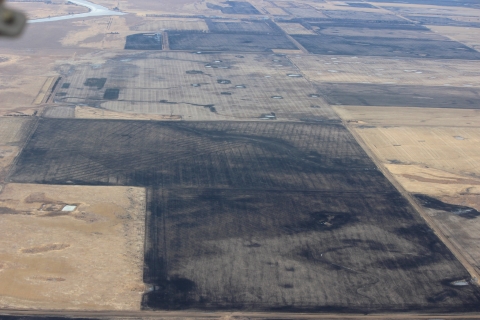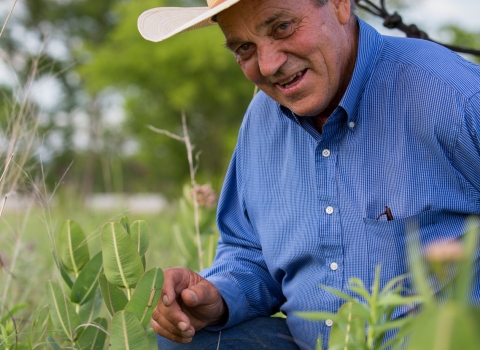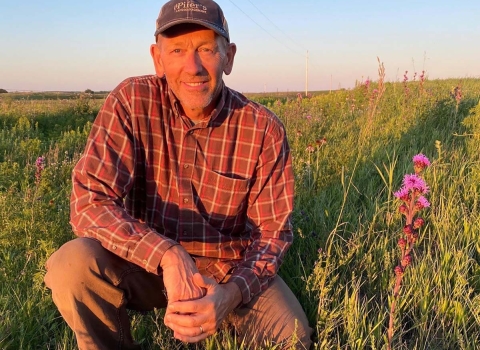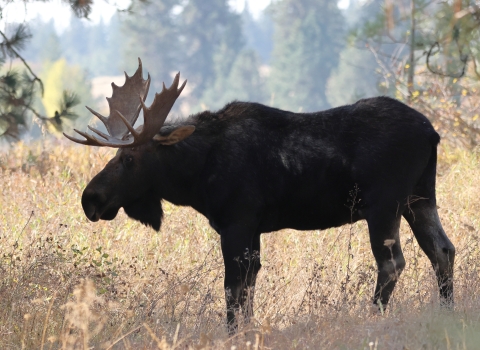If you were to stand on Chad and Jennifer Kunz’s farm and look across the vast prairie, you might spot a red-tailed hawk sailing low over the blanket of grass that covers the rolling hills, or if you're really lucky, you could witness a sharp-tailed grouse lek, one of the most complex and performative bird mating rituals in the world. It’s a peaceful oasis in the prairie potholes of central North Dakota, where wildlife is abundant, people are friendly, and there is always something to do in the great outdoors.
What Chad and Jennifer Kunz see is a legacy tied to that of the Great American West. The Kunz family settled on their piece of land a century ago and started a life on the prairie. What we see today is testament to the dedication of these stewards of the land, however, conservation has not always been part of the history of our grasslands.
In the 1920s, in the aftermath of World War I, farmers were challenged to produce enough food to feed a nation. As a result of increased production costs and tumbling prices, driven by the falling demand for U.S. exports, many farmers cultivated “submarginal” land for agricultural production. Lands that wouldn’t previously have been considered viable for farming were converted into functioning farmland to meet the growing demand for food.
In the 1930s, the federal government began providing free engineering services to farmers to drain their wetlands, and in the 1940s, the government began sharing the cost of wetland drainage with farmers. Many farmers felt they had no choice but to drain their wetlands and cultivate their grasslands, in an effort to address the many societal challenges that existed.
Before we condemn these landowners for destroying wetland habitat, it’s important to remember that post-World War II America was a different place. We were a burgeoning country with a new attitude of self-reliance when it came to our food source. Converting “submarginal,” swampy land into productive farmland wasn’t just a financial decision, it was a patriotic one.
By the 1950s, a coordinated effort was well underway to remove surface water from wetlands so those lands could be profitable. This continued all the way into the 1980s, when priorities shifted to conservation. In the 1985 Farm Bill, this practice was coined “Swampbusting,” formally defined as converting wetlands for the specific purpose of producing an agricultural commodity. The Farm Bill included a provision officially titled the “Wetland Conservation provisions of the Food Security Act of 1985”, commonly known as the Swampbuster provision, which discourages the conversion of wetlands to cropland use.
Today, the practice of draining wetlands is highly discouraged, but the scars from past actions are still visible on the landscape. When Chad and Jennifer Kunz took over their parcel of land in 2014, they were interested in finding a way to restore their wetlands to their natural state. Although some producers’ attitudes toward wetlands in North Dakota can still be quite negative, others, like the Kunz family, embrace them as an integral part of a healthy ecosystem and not a hinderance.
Although the government did previously sanction the draining of these wetlands, fortunately it is now working with landowners like the Kunz family to repair some of the mistakes of the past. Another measure introduced in the 1985 Farm Bill was the Conservation Reserve Program, or CRP. The primary purpose of the CRP is to conserve soil, water, and wildlife through conservation efforts focused on ecosystems like grasslands and wetlands. Through programs like the CRP, many landowners had the opportunity to conserve their natural resources without suffering economic hardships. Chad’s father enrolled their land in the CRP in 1987, which began the Kunz family’s wetland restoration journey.
When Chad and Jennifer moved onto the land in 2014, there wasn’t much with which they could work. “We had a cabin without water or a bathroom – but we had fiber Internet, so we made it work,” Jennifer said, laughing as she recalled their humble beginnings. They’ve since built a beautiful home for themselves and have grown quite attached to their land.
When it came time to re-enroll in the CRP, Chad and Jennifer began to explore other options and made the decision to instead sign an easement with the U.S. Fish and Wildlife Service in 2018. Although the CRP program is a wonderful tool for keeping grass on the landscape, it’s a short-lived commitment. Chad and Jennifer looked back on the difficulties of farming this property and believed an easement would be a better long-term option. Selling Grassland and Wetland Easements to the U.S. Fish and Wildlife Service accomplished their goal of preserving that grassland in perpetuity.
Additionally, the proceeds from selling the easement made it possible for them to show that their commitment wasn’t a donation but rather an investment in their future and a first step toward leaving the land better than they found it. In 2019, work began to restore the grasslands and wetlands, with help from the Service and funding partners such as the North Dakota Natural Resources Trust. Since then, 83 acres of drained wetlands have been restored on their land. Additionally, to facilitate the change to grazing agriculture, they erected over 9 miles of fence, installed a cattle water well, and established three watering tanks on the property in an effort improve the forage quality for their livestock and the overall health of the soil.
“We made the wetlands productive in a different way,” Chad said. “Agriculture has a major presence in this area, and grasslands just aren’t regarded as highly – but marginal farmland is probably better used as grasslands. We all need to eat, but we also need balance; we can’t pit one against the other. We made the decision to transform the land into working lands for grazing.” Today, Chad and Jennifer lease their land to cattle producers. “Nowadays, it’s a financially sensible decision. Conservation doesn’t have to be pure benevolence – it can also be a good economic decision.”
They have also found that proper land management has resulted in more money earned per acre. By restoring their wetlands, they have increased the water storage capacity of their land, as well as the aquifers below. Along with the ecological benefits that stem from a healthy water cycle, Chad and Jennifer turned their water into a source of income. “Better water leads to bigger animals, and bigger animals mean money. Water is the number one need for any animal.”
And Jennifer and Chad are already seeing the ecological benefits. “We have gone from drought to a lot of water. It used to be cattails and murky areas filled with sediment; now all of these different forbs [flowering plants] are growing. Plants, bugs, pollinators, ducks – it's full of life. We’ve even seen pelicans, which is indicative of aquatic life.” Jennifer has also found what she believes to be a sharp-tailed grouse lek. “It has been rewarding. The sounds of life are so striking. We are seeing the land heal itself.”
When asked about the community response to their efforts, Jennifer and Chad shared that they have seen a gradual shift in perspectives. “When I was growing up, ‘potholes’ for ducks was a curse word,” Chad said. “There are still strong opinions about wetland easements, ducks, and potholes, but as generations change, those memories are starting to fade into history. Our work has inspired others to look into easements and decide for themselves whether it is the right decision for them.”
Chad and Jennifer recognize that potholes can be an inconvenience for landowners, but they believe it’s worth it when the aquifers do better. They also see the value in sharing the benefits with their community. Chad and Jennifer enrolled their land into the North Dakota Game and Fish Private Land Open to Sportsmen (PLOTS) program, which opens the land up to public hunting. Through this program, they share their land with their community. Jennifer shared how they are helping to inspire a love of our natural areas for the next generations:
“Protecting and restoring natural areas directly impacts younger generations’ interest in natural areas and outdoor recreation. Sportsmen organizations fund a lot of conservation because they recognize the need for, and value, of these natural areas. The next generations need access to nature in order to grow an appreciation for it – with so much land privately owned and used for agriculture, they don’t have the same opportunities as we did. By restoring these natural spaces, and sharing our land with the community, we are giving the next generations the opportunity to discover their connection to nature.”
Just as with conservation, this story was a product of collaboration with our partners and colleagues across the country. Written by Christina Stone in collaboration with Chris Flann, Scott McLeod, Katie Nuessly, John Carlson, Jerry Reinisch, Laura Jenkins, Matt Trott, and - with special thanks - Chad and Jennifer Kunz.








